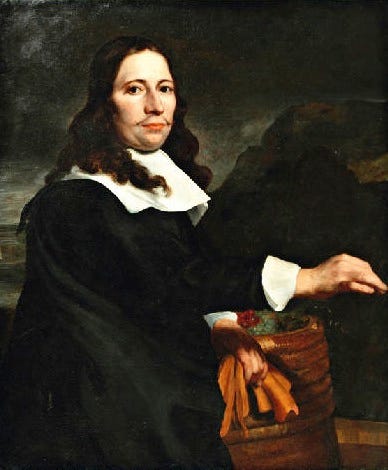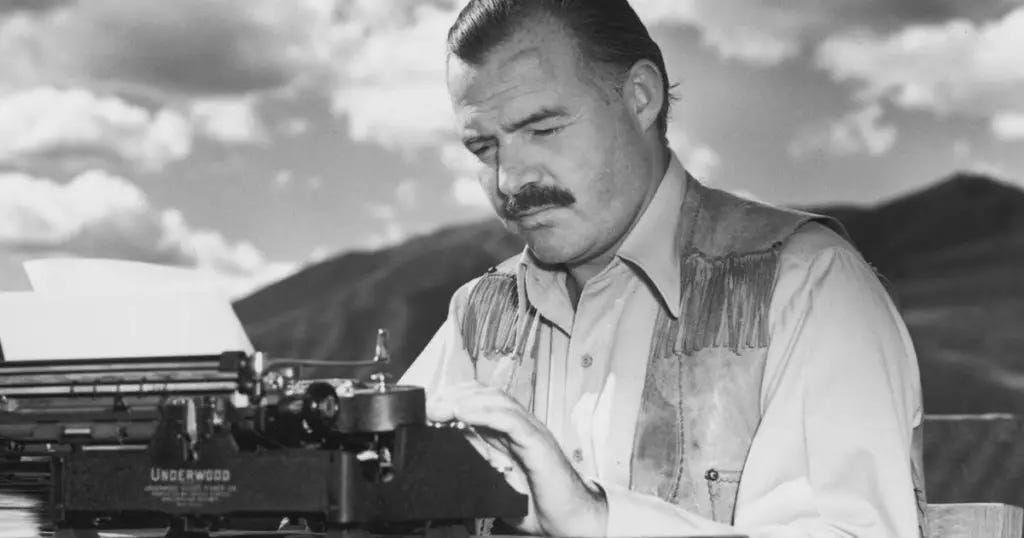Hi there👋
Forgive me. I haven’t written in a while. Day-to-day responsibilities got the best of me. I loved writing this newsletter, so I’m starting again. I hope you’ll join me on the journey.
Today’s stories in a nutshell (each one is digestible in less than 2min):
🇿🇦 Why is everything named after this dude?
✍️ A writing tip from Stephen King
🎧 Getting fit
🎸 A song about the devil
🇿🇦 South African History: Who was this guy, and why is everything named after him? (It’s not Jan van Riebeeck)
After a few years of scouring what Europe has to offer, South Africa’s magnetic pull yanked us back home. The lure of a new adventure and the beckoning of familial ties led us to the Cape Winelands, where I once lived as a student. I didn’t learn too much about the area and its history when I studied here many years ago — time at the pub seemed a more fruitful endeavour. This gap in my knowledge now irks me.
It’s time to remedy that.
Simon van der Stel is a name you can't escape in these parts, etched onto every corner. Thus, the OG of the Boland seemed like a logical starting point for my history lesson.
Here are the eight most interesting titbits I learned:
He was part of the Dutch East India Company and was the first Governor of the Dutch Cape Colony from 1679 to 1699.
In 1685, he established South Africa's oldest wine-producing estate, Groot Constantia. He named it after his wife, Constance.
Under his watch, the Dutch East India Company established many vineyards in the Cape region and began exporting wine to Europe. He brought in grape varieties from Europe, like Chenin Blanc and Muscat. 💡Fun fact: Today, Chenin Blanc is the most planted wine grape variety in South Africa.
At the time, Christians in France were forbidden to practise the Protestant religion and needed to flee the country. Van der Stel saw an opportunity. Knowing that these French Huguenot settlers had winemaking skills, he granted them free passage to the Cape Colony. He gave them land in the Drakenstein Valley, which helped establish Paarl and Franschhoek - towns now renowned for their wine.
He also founded Stellenbosch (the second oldest European settlement in SA) in a fertile valley near the Eerste River because of the region's potential for agriculture and its strategic location for trade. He designed the town's layout, including streets, public spaces, and infrastructure. Simonsberg, the iconic mountain that overlooks the town, was named in his honour.
Though not founded by van der Stel, Simon's Town, located on the eastern side of the Cape Peninsula, became a winter anchorage for the Dutch East India Company's ships during his tenure. He recognised the strategic importance of the bay and its sheltered waters, which eventually led to the town's development and the establishment of a naval base.
In 1681, van der Stel visited Hout Bay, noting its potential for timber production to aid the expanding Cape Colony. "Hout Bay”, translating to "Wood Bay," likely got its name from the once dense Yellowwood forests in the area. Although van der Stel didn't establish a settlement, his exploration paved the way for future development.
Like many historical icons, his legacy is tainted. Van der Stel was a slave owner and, as Governor, expanded the slave trade in the Cape Colony, which involved not only importing more slaves but also regulating their treatment, working conditions, and the trade itself. Slaves from all over Africa, Madagascar, India, and the East Indies were brought to aid the colony's development. Later on, many of the indigenous Khoikhoi people were also forced into servitude.
You should try to unearth the history of where you live. You might find that the past illuminates your present and feel a deeper connection to your surroundings. Just like it did for me.
✍️ Useful skill: Aggressively prune those adverbs
When we write, it’s tempting to sprinkle the text with adverbs to add colour to our writing. But that’s like adding ketchup to a rib-eye steak.
Don’t
…do
…it!
In case you’ve forgotten what you learned in school:
Adjectives describe nouns or pronouns 👉 happy dog
Adverbs modify verbs, adjectives, or other adverbs, often ending in "-ly" 👉 dog barks loudly
Adverbs clutter. That’s why the best writers keep them to a minimum:
Bestselling author Stephen King is known for his hatred of adverbs. In his book On Writing: A Memoir of the Craft, he writes:
Consider the sentence He closed the door firmly. It’s by no means a terrible sentence, but ask yourself if firmly really has to be there. You can argue that it expresses a degree of difference between He closed the door and He slammed the door, and you’ll get no argument from me … but what about context? What about all the enlightening (not to say emotionally moving) prose which came before He closed the door firmly? Shouldn’t this tell us how he closed the door? And if the foregoing prose does tell us, isn’t firmly an extra word? Isn’t it redundant?
Someone out there is now accusing me of being tiresome and anal-retentive. I deny it. I believe the road to hell is paved with adverbs, and I will shout it from the rooftops. To put it another way, they’re like dandelions. If you have one on your lawn, it looks pretty and unique. If you fail to root it out, however, you find five the next day … fifty the day after that … and then, my brothers and sisters, your lawn is totally, completely, and profligately covered with dandelions. By then you see them for the weeds they really are, but by then it’s – GASP!! – too late.
🎧 What I’m listening to: Health vibes
How seriously do you take your physical health?
I’ve been useless of late.
The convenient excuse of small kids and a lot of travel for work made me lazy. To my horror, I developed a dadbod. I became what you’d call…
Um…skinny fat. Thin arms, potbelly.
But as I’m nearing 40, it’s time to turn a new leaf.
If you are on the same journey, I recommend Huberman Lab’s 6-part interview series with Dr Andy Galpin, an expert on exercise science.
Physical fitness comes in many forms. In the first episode, he discusses the 9 different types of physical adaptations that can be used to transform the functional capabilities and aesthetics of your body. Essentially you want to focus on all of these if you want to be truly fit. Each also has its own health benefit.
The 9 adaptations, in short:
💪 Skill or Technique: Learning to move more effectively.
💪 Speed: Moving at a higher velocity or with a better rate of acceleration.
💪 Power: Speed multiplied by force. E.g. box jump
💪 Strength: How effectively you can move something. E.g. 1 rep max deadlift
💪 Muscle Hypertrophy: The size of your muscle. Although related, you can be strong without large muscles.
💪 Muscular Endurance: How many reps in a row can you do, localised to specific muscles or muscle groups? E.g. Consecutive pushups
💪 Anaerobic Capacity: It's your body's turbo boost for short, intense bursts of exercise, using energy stored in muscles when there's not enough oxygen.
💪 Maximal Aerobic Capacity: Often known as VO2 max. The greatest amount of oxygen your body can consume, transport, and use during intense or maximal exercise.
💪 Long Duration: Your ability to sustain submaximal work for a long time with no breaks or reduction. E.g. Steady running on a treadmill.
If this tickle’s your fancy - here’s part 1 of the interview series:
*You can find the podcast versions here.
🎸 Weekend Song: Sympathy for the Devil by the Rolling Stones
“Please allow me to introduce myself
I'm a man of wealth and taste
I've been around for a long, long years
Stole million man's soul an faithAnd I was 'round when Jesus Christ
Had his moment of doubt and pain
Made damn sure that Pilate
Washed his hands and sealed his fatePleased to meet you
Hope you guess my name
But what's puzzling you
Is the nature of my gameStuck around St. Petersburg
When I saw it was a time for a change
Killed Tsar and his ministers
Anastasia screamed in vainI rode a tank
Held a general's rank
When the blitzkrieg raged
And the bodies stankPleased to meet you
Hope you guess my name, oh yeah
Ah, what's puzzling you
Is the nature of my game, oh yeah”
Last year, I was lucky enough to watch the Rolling Stones live in front of 60 000 people.
Electric. Incredible. Unforgettable.
Inspired by the likes of Muddy Waters, Howlin’ Wolf and Bo Didley, Keith Richards and Mick Jagger were originally in a band called the Blues Boys. But after shuffling band members, they became the Rolling Stones in the early sixties, named after a Muddy Waters song, Rollin’ Stone.
"Sympathy for the Devil" is a Stones classic from the band's 1968 album Beggars Banquet. The song serves as a commentary on historical horrors, with the devil himself as the narrator, recounting tales of the Crucifixion, the Russian Revolution, and the devastation of World War II. The lyrics insinuate his involvement in these brutal events, yet the song ventures deeper.
It holds up a mirror to humanity, emphasising that evil isn't merely a supernatural phenomenon, but a potential that lurks within us all. It highlights our propensity to project our malevolent deeds onto external entities, like the devil, absolving ourselves of responsibility.
But sometimes, we have to accept our own culpability.






